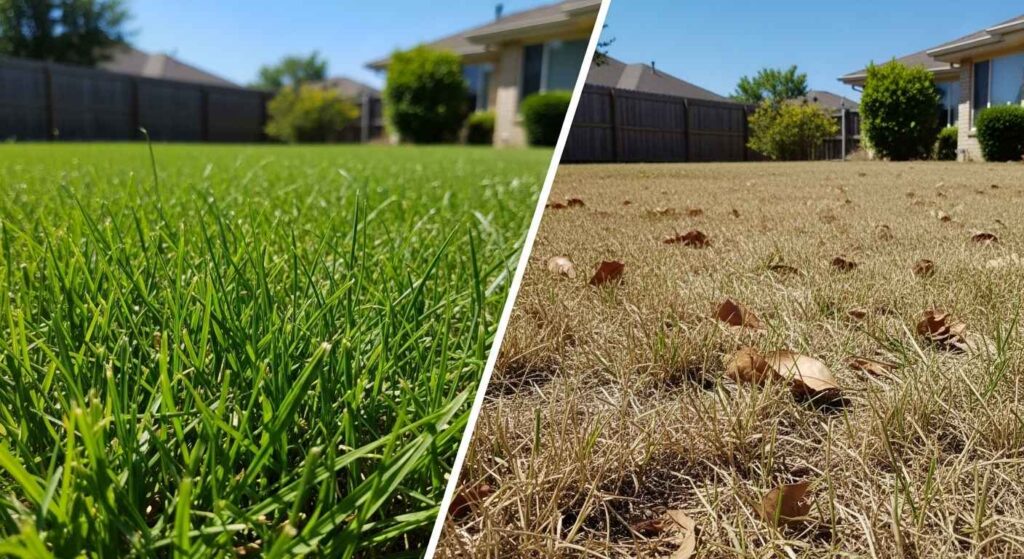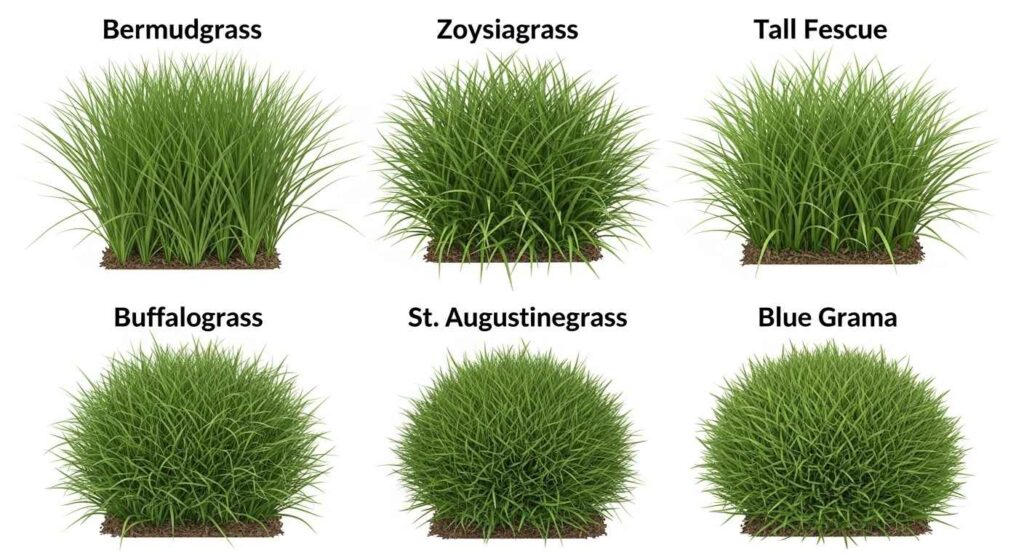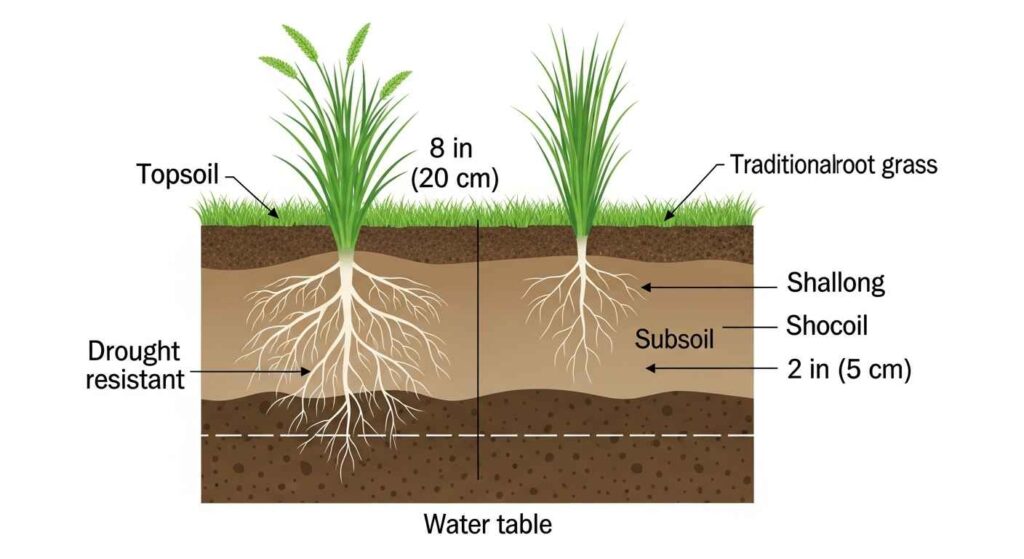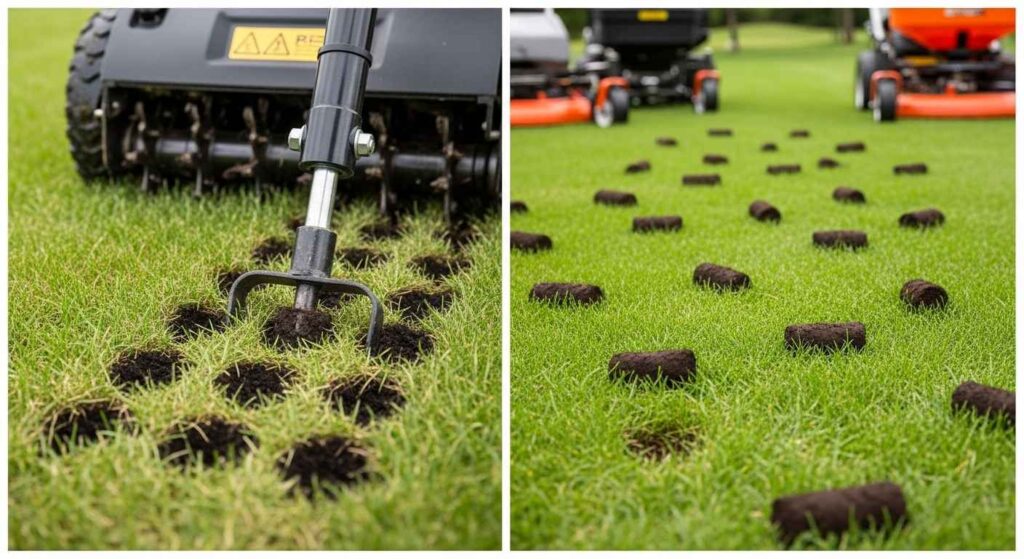Water restrictions, rising utility bills, and scorching summer heat don’t have to mean a brown, dead lawn. Creating a drought-resistant lawn saves money, conserves water, and keeps your yard looking healthy year-round. This guide shows you exactly how to build a lawn that thrives even during the driest months.
Why Your Lawn Needs Drought Resistance
A drought-tolerant lawn features a deep and extensive root system that reaches water sources far below the surface. Most homeowners water their lawns incorrectly, creating shallow root systems that fail during dry spells.
Benefits of a drought-resistant lawn:
- Cuts water bills by 30-50%
- Survives water restrictions
- Requires less maintenance
- Stays green longer during dry periods
- Increases property value

Best Drought-Tolerant Grass Types
Drought-tolerant grasses like bermuda grass, zoysia, buffalograss, and tall fescue work best for dry conditions. Each grass type suits different climates and use levels.
Warm-Season Grasses
Bermuda Grass
- Handles extreme heat and drought
- Goes dormant in winter (turns brown)
- Perfect for high-traffic areas
- Needs full sun
Zoysia Grass
- Thick, carpet-like texture
- Handles foot traffic well and varies in texture from fine to coarse
- Slower to establish but very durable
- Works in partial shade
Buffalo Grass
- Native to North America
- Extremely low water needs
- Natural gray-green color
- Best for low-traffic areas
Cool-Season Options
Tall Fescue
- Deep, dense roots access water far below the surface
- Stays green longer during drought
- Handles moderate foot traffic
- Good for transition zones
Fine Fescue
- Perfect for shaded areas and low-maintenance lawns
- Very drought tolerant once established
- Requires minimal mowing
- Creeping red and chewing varieties work best

Smart Watering Techniques
Less frequent, longer irrigations help establish a deeper root system. Most people water wrong by applying small amounts several times weekly.
The Deep Watering Method
When to Water: Water only when 30 to 50 percent of your lawn shows wilt signs:
- Grass blades fold or curl
- Color turns blue-gray
- Footprints stay visible for several seconds
How Much Water:
- Apply ½ to ¾ inch per session
- Use ¾ inch for sandy soils, ½ inch for clay soils
- Water until soil is moist 6-8 inches deep
Best Time to Water:
- Early morning (4-6 AM) reduces evaporation
- Avoid evening watering (promotes disease)
- Never water during midday heat
Water-Saving Tips
- Install rain sensors on automatic systems
- Use drip irrigation for targeted watering
- Collect rainwater in barrels
- Check for leaks in hoses and sprinklers

Proper Mowing for Drought Resistance
Mowing at the highest recommended height increases leaf area and creates deeper root systems. Cutting grass too short weakens the plant and reduces drought tolerance.
Mowing Height Guidelines
Warm-Season Grasses:
- Bermuda: 1-2 inches
- Zoysia: 1-3 inches
- Buffalo: 2-4 inches
Cool-Season Grasses:
- Tall fescue: 3-4 inches
- Fine fescue: 2-3 inches
Mowing Best Practices
- Never cut more than one-third of the blade length
- Keep mower blades sharp for clean cuts
- Reduce mowing frequency during drought
- Leave grass clippings to add moisture and nutrients
Soil Preparation and Amendments
Healthy soil creates stronger, more drought-resistant grass. Poor soil holds less water and nutrients, making your lawn more vulnerable to dry conditions.
Soil Testing
Test your soil pH and nutrient levels every 2-3 years. Most grasses prefer pH between 6.0-7.0. Contact your local extension office for testing services.
Soil Improvements
For Clay Soil:
- Add compost to improve drainage
- Aerate annually to reduce compaction
- Consider raised beds for severe cases
For Sandy Soil:
- Mix in organic matter to retain moisture
- Apply mulch around grass areas
- Use slow-release fertilizers
Organic Amendments:
- Compost improves water retention
- Peat moss helps sandy soils hold moisture
- Well-aged manure adds nutrients slowly
Aeration Benefits
Core aeration twice yearly:
- Allows water to penetrate deeper
- Reduces soil compaction
- Improves root growth
- Best done in spring and fall

Fertilizing During Drought Conditions
Fertilization during drought should be reduced or postponed because nitrogen encourages shoot growth rather than root development. This creates weak grass that suffers more during dry periods.
Drought-Period Fertilizing Rules
What to Avoid:
- High-nitrogen fertilizers
- Quick-release formulas
- Fertilizing dry, stressed grass
Better Options:
- Slow-release nitrogen and phosphorus sources
- High potassium fertilizers (third number on bag) enhance drought tolerance
- Iron applications keep grass green without promoting growth
Application Tips
- Water lightly after applying (¼ inch)
- Apply only to moist soil
- Follow package directions exactly
- Consider organic options like compost
Identifying and Managing Lawn Stress
Recognizing early drought stress helps you take action before permanent damage occurs. Stressed grass shows specific warning signs that indicate when intervention is needed.
Early Warning Signs
Visual Symptoms:
- Grass blades fold lengthwise
- Color changes from green to blue-gray
- Footprints remain visible after walking
- Growth slows noticeably
Advanced Stress Signals:
- Brown patches appear
- Grass feels crispy to touch
- Weeds increase in thin areas
- Recovery takes longer after rain
Recovery Strategies
Immediate Actions:
- Apply deep watering session
- Avoid foot traffic on stressed areas
- Skip mowing until recovery begins
- Remove weeds competing for water
Long-term Recovery:
- Overseed thin areas in fall
- Apply light compost topdressing
- Adjust irrigation schedule
- Consider grass type changes
Alternative Landscaping Options
Sometimes traditional grass isn’t the best choice for extremely dry climates or water-restricted areas. Consider these alternatives that require minimal watering.
Low-Water Ground Covers
Clover Lawns:
- Stays green with little water
- Fixes nitrogen naturally
- Handles moderate foot traffic
- Flowers attract beneficial insects
Native Ground Covers:
- Creeping raspberry and wild strawberries work well in dappled shade
- Require no supplemental watering once established
- Support local wildlife
- Reduce maintenance needs
Xeriscaping Elements
Rock Gardens:
- Zero water requirements
- Add visual interest year-round
- Work well with drought-tolerant plants
- Require minimal maintenance
Native Plant Borders:
- Frame remaining grass areas
- Create wildlife habitat
- Reduce overall lawn size
- Provide seasonal color

Maintenance Calendar for Drought-Resistant Lawns
Following a seasonal maintenance schedule keeps your drought-resistant lawn healthy year-round without wasting water or effort.
Spring Tasks (March-May)
- Test soil pH and nutrients
- Aerate compacted areas
- Apply slow-release fertilizer if needed
- Overseed bare spots with drought-tolerant varieties
- Clean and test irrigation systems
Summer Care (June-August)
- Water deeply but less frequently
- Mow at maximum recommended height
- Watch for early stress signs
- Avoid fertilizing during heat waves
- Hand-pull weeds competing for water
Fall Preparation (September-November)
- Overseed thin areas before winter
- Apply final fertilizer application
- Continue deep watering until dormancy
- Rake leaves promptly to prevent smothering
- Aerate again if needed
Winter Maintenance (December-February)
- Plan lawn improvements for next year
- Service mower and irrigation equipment
- Research new drought-tolerant grass varieties
- Avoid walking on frozen grass
- Apply pre-emergent herbicides in late winter
Common Mistakes That Reduce Drought Resistance
Avoiding these common errors helps ensure your drought-resistant lawn succeeds from the start.
Watering Mistakes
- Daily light watering: Creates shallow roots
- Watering stressed grass: Can cause more damage
- Ignoring rainfall: Leads to overwatering
- Evening irrigation: Promotes disease problems
Mowing Errors
- Cutting too short: Weakens grass during stress
- Dull blades: Create ragged cuts that lose moisture
- Mowing wet grass: Spreads diseases
- Removing all clippings: Eliminates natural mulch
Fertilizer Problems
- Over-fertilizing: Forces weak, water-dependent growth
- Wrong timing: Fertilizing during drought stress
- High nitrogen: Promotes shoots instead of roots
- Skipping soil tests: Leads to nutrient imbalances
Cost Savings and Environmental Benefits
Creating a drought-resistant lawn provides significant financial and environmental advantages beyond just having an attractive yard.
Financial Benefits
- Reduce water bills by 30-50% annually
- Lower maintenance costs over time
- Increase property value
- Avoid lawn replacement expenses during droughts
- Reduce fertilizer and pesticide needs
Environmental Impact
- Conserve local water resources
- Reduce runoff and erosion
- Support beneficial insects and wildlife
- Decrease chemical inputs to groundwater
- Lower carbon footprint from reduced maintenance
Getting Started: Your Action Plan
Transform your lawn into a drought-resistant landscape with this step-by-step approach:
Week 1-2: Assessment
- Test your current grass type
- Evaluate soil conditions
- Identify problem areas
- Research best grass varieties for your region
Week 3-4: Soil Preparation
- Test soil pH and nutrients
- Aerate compacted areas
- Add organic amendments as needed
- Plan irrigation improvements
Month 2-3: Installation
- Plant new drought-tolerant grass varieties
- Adjust or install efficient irrigation
- Establish proper mowing height
- Begin deep watering schedule
Month 4+: Maintenance
- Monitor grass establishment
- Fine-tune watering schedule
- Address any problem areas
- Plan seasonal maintenance tasks
Your drought-resistant lawn will save water, reduce maintenance, and stay green even during the hottest, driest weather. Start with proper grass selection and soil preparation, then maintain it with smart watering and mowing practices. The investment in creating a drought-resistant lawn pays dividends in lower bills, less work, and a beautiful yard that thrives year-round.
For more home and garden tips that save time and money, check out our guides on organizing small spaces and eco-friendly cleaning solutions.
